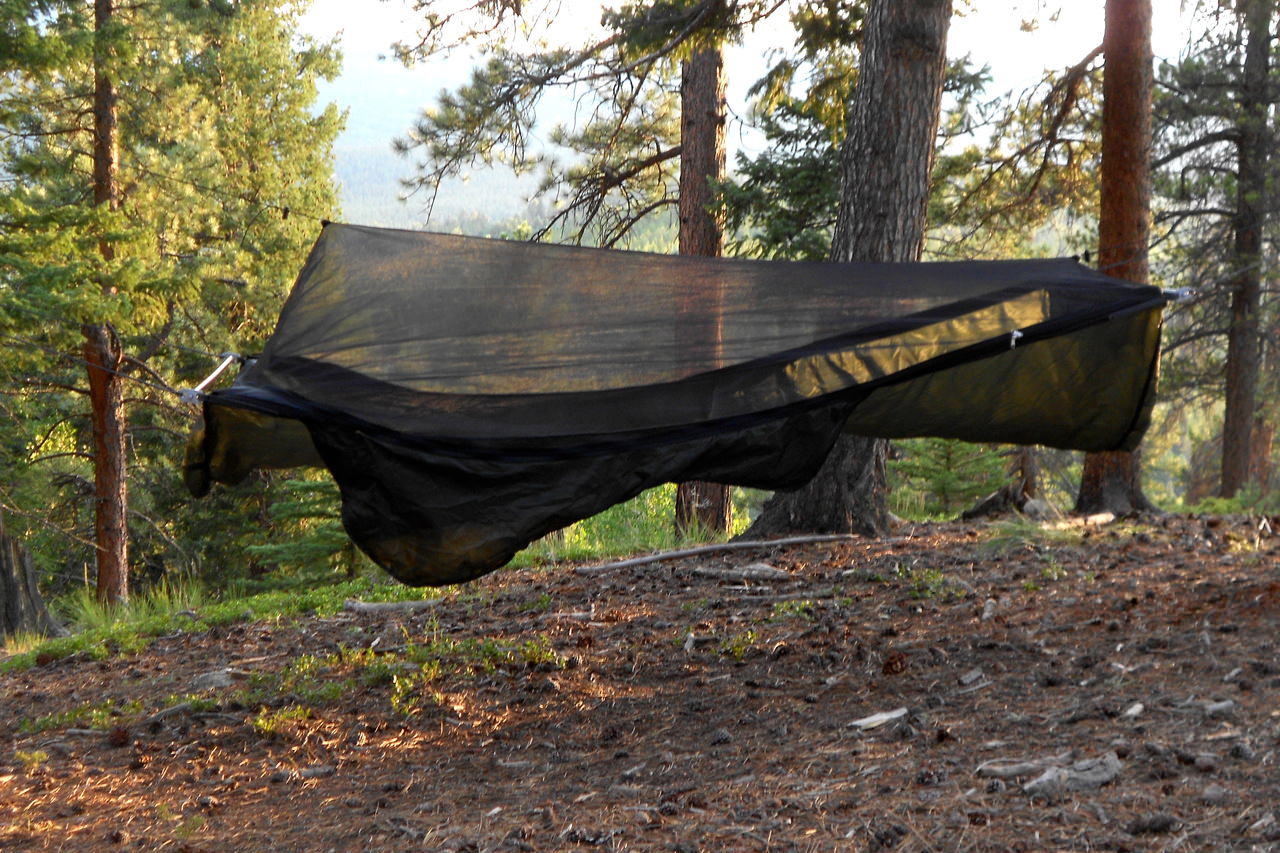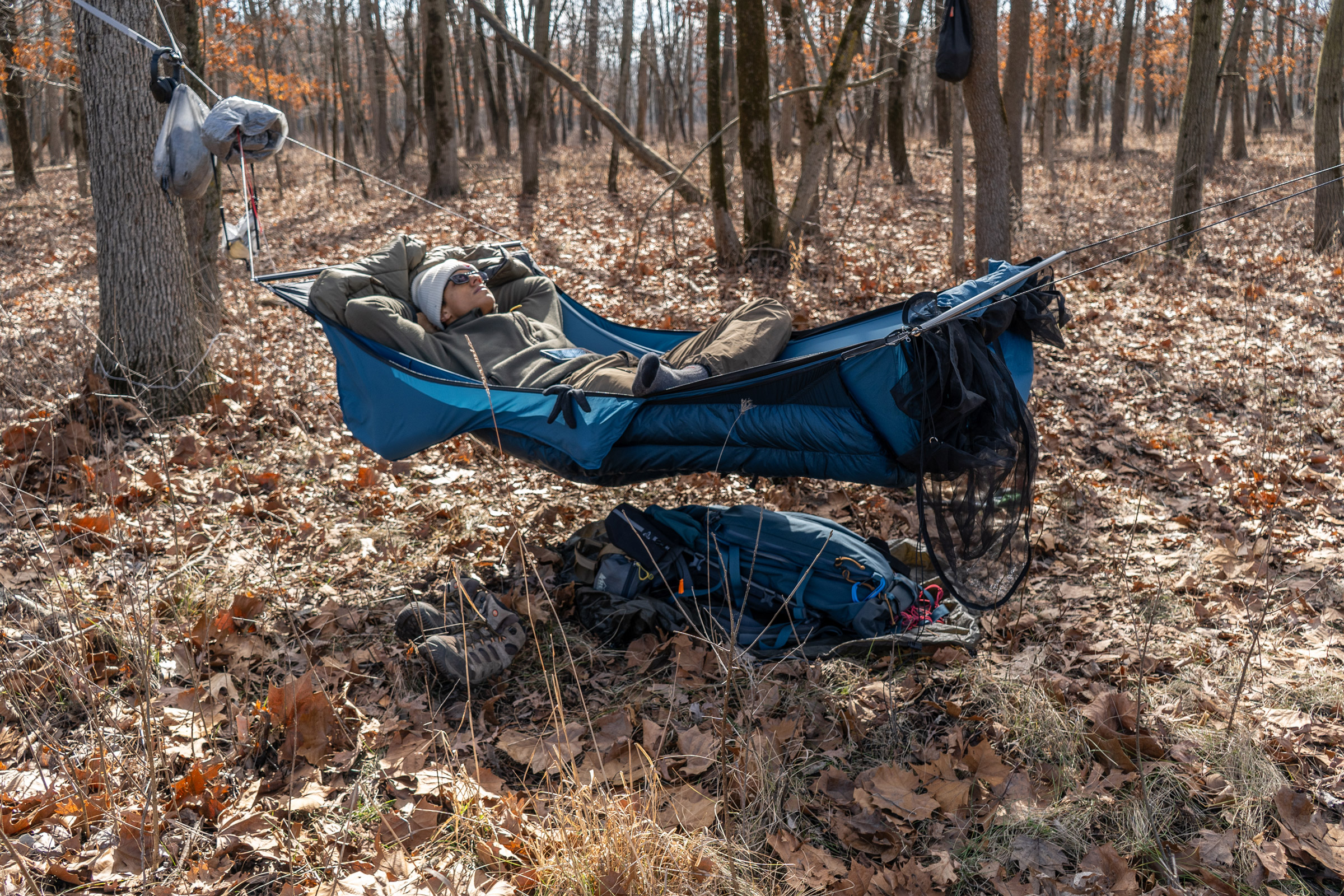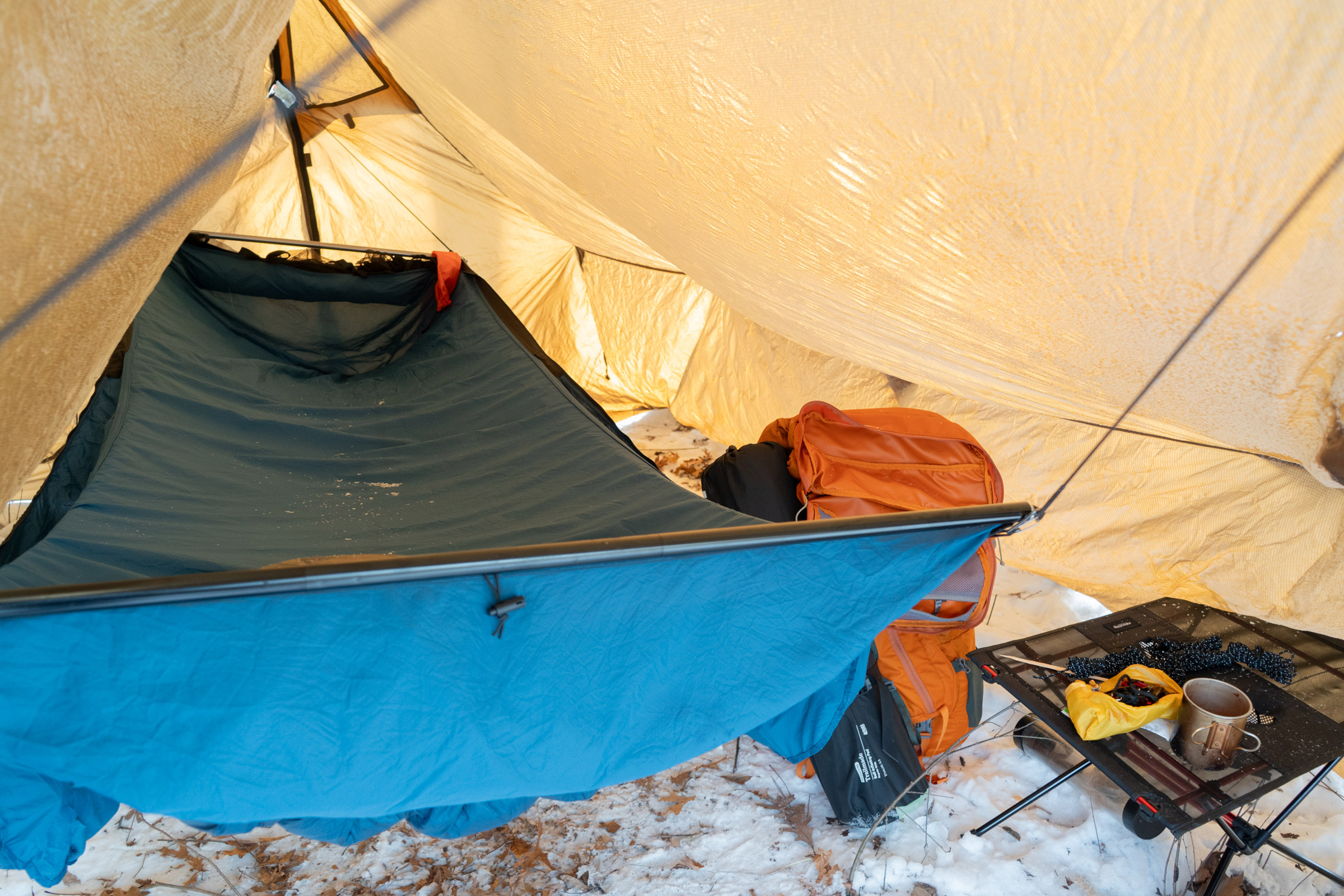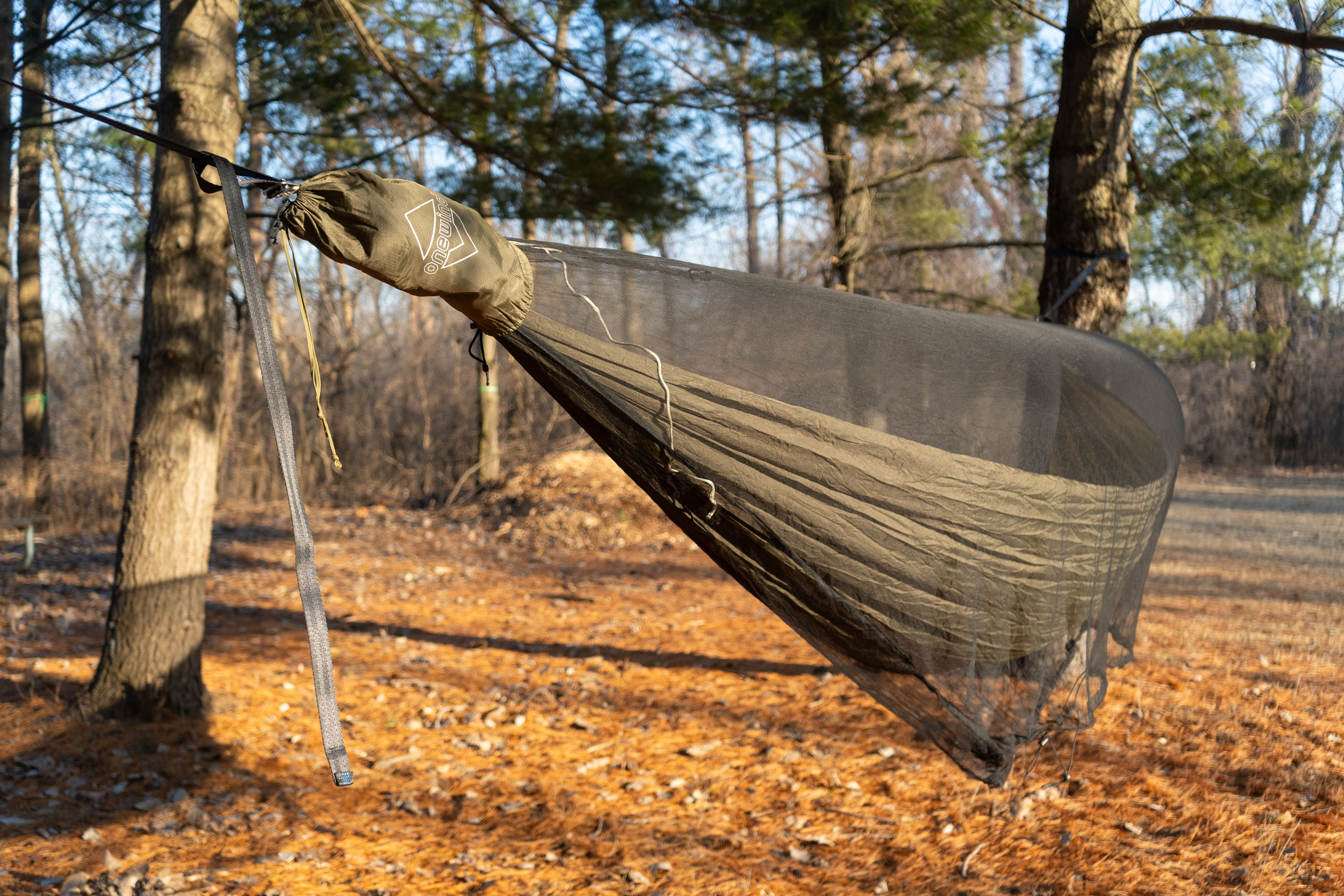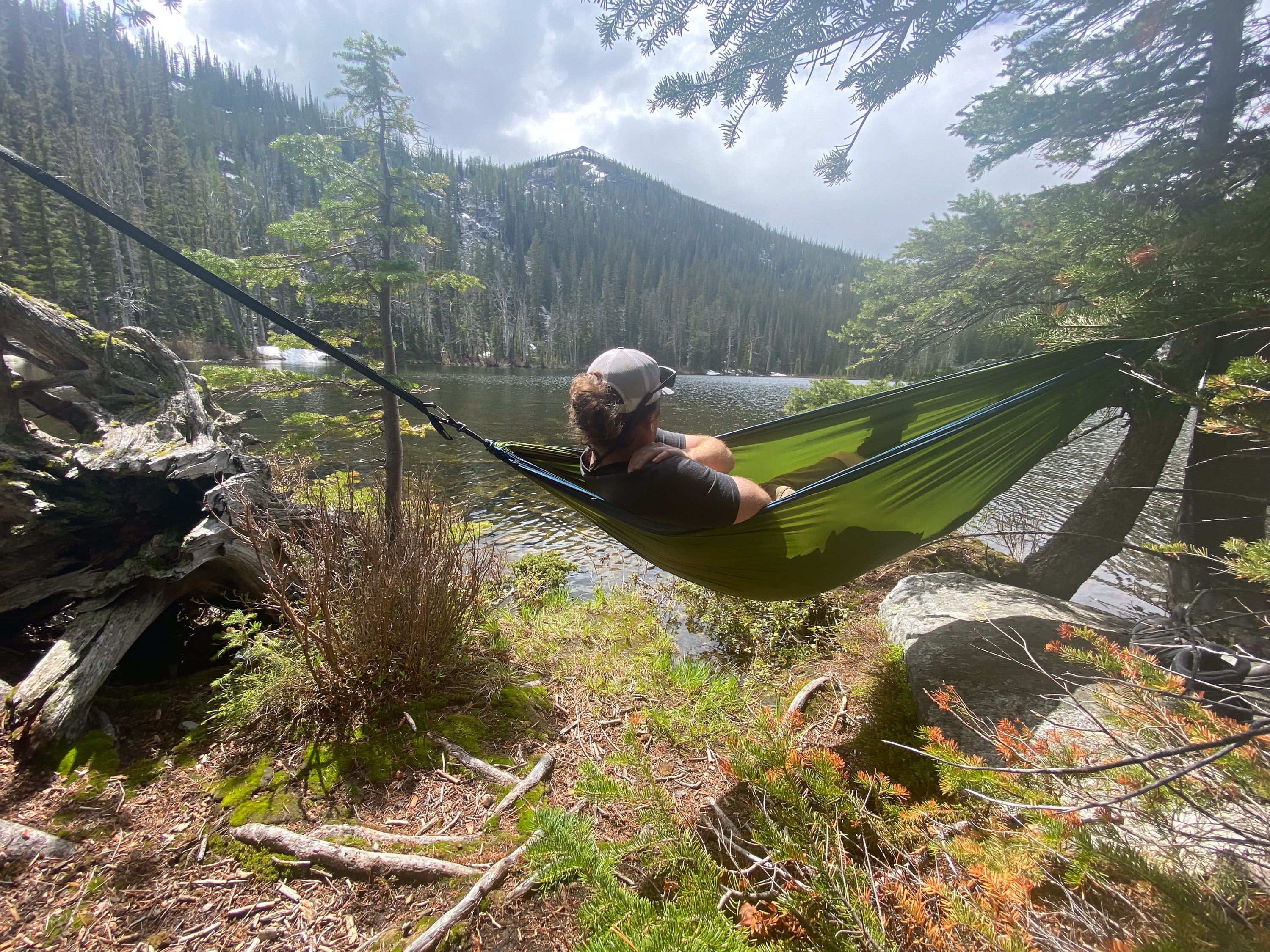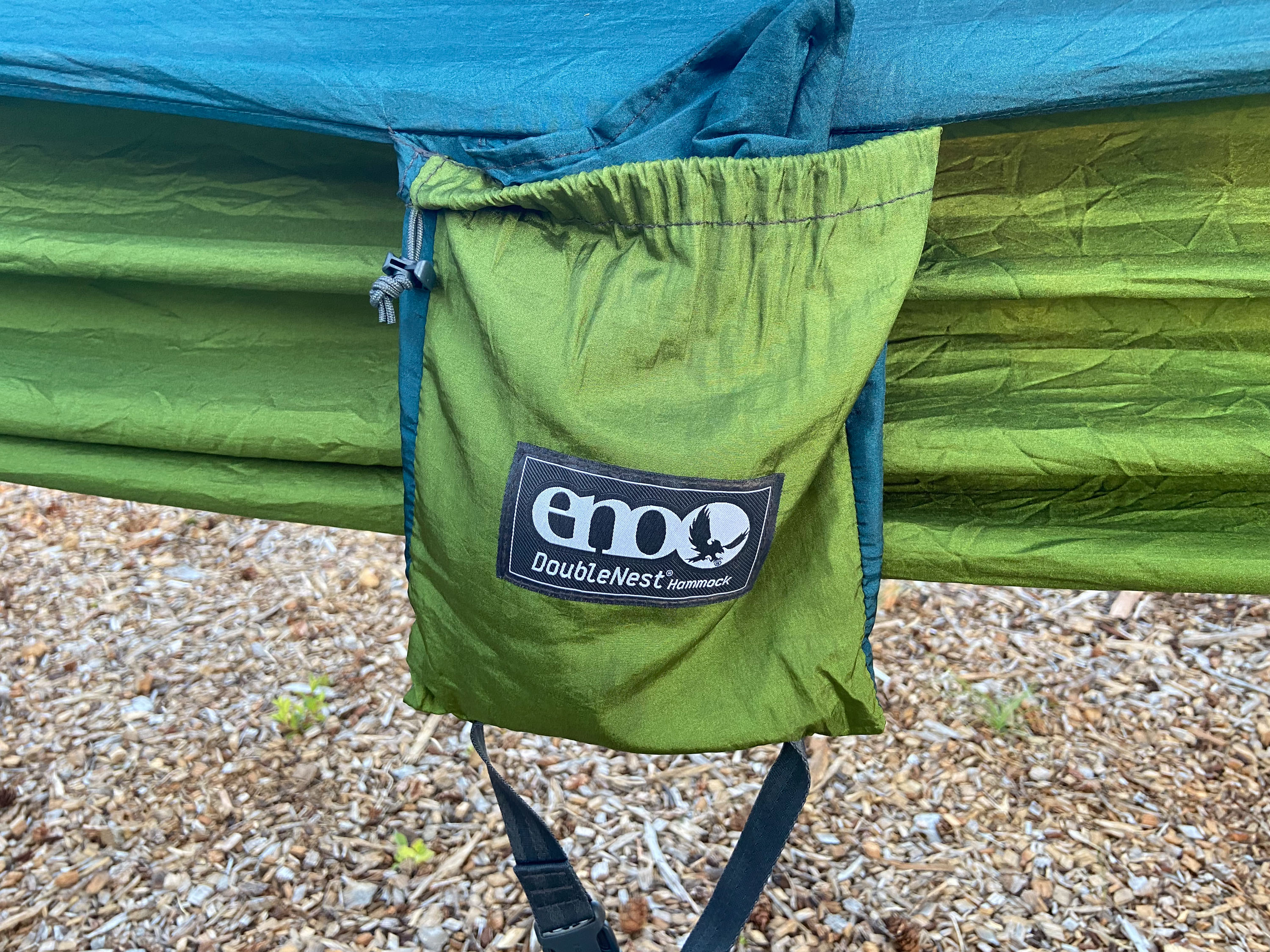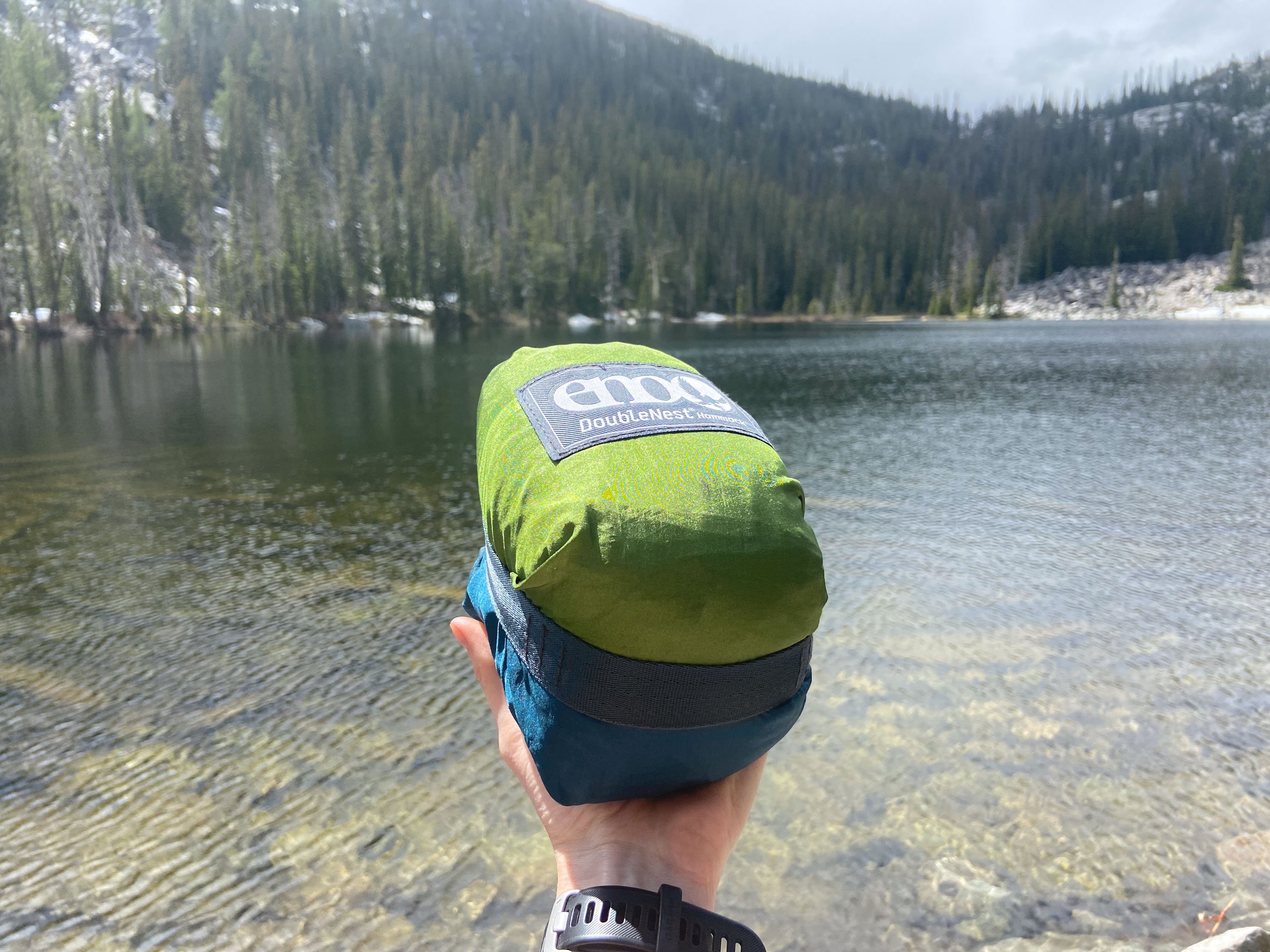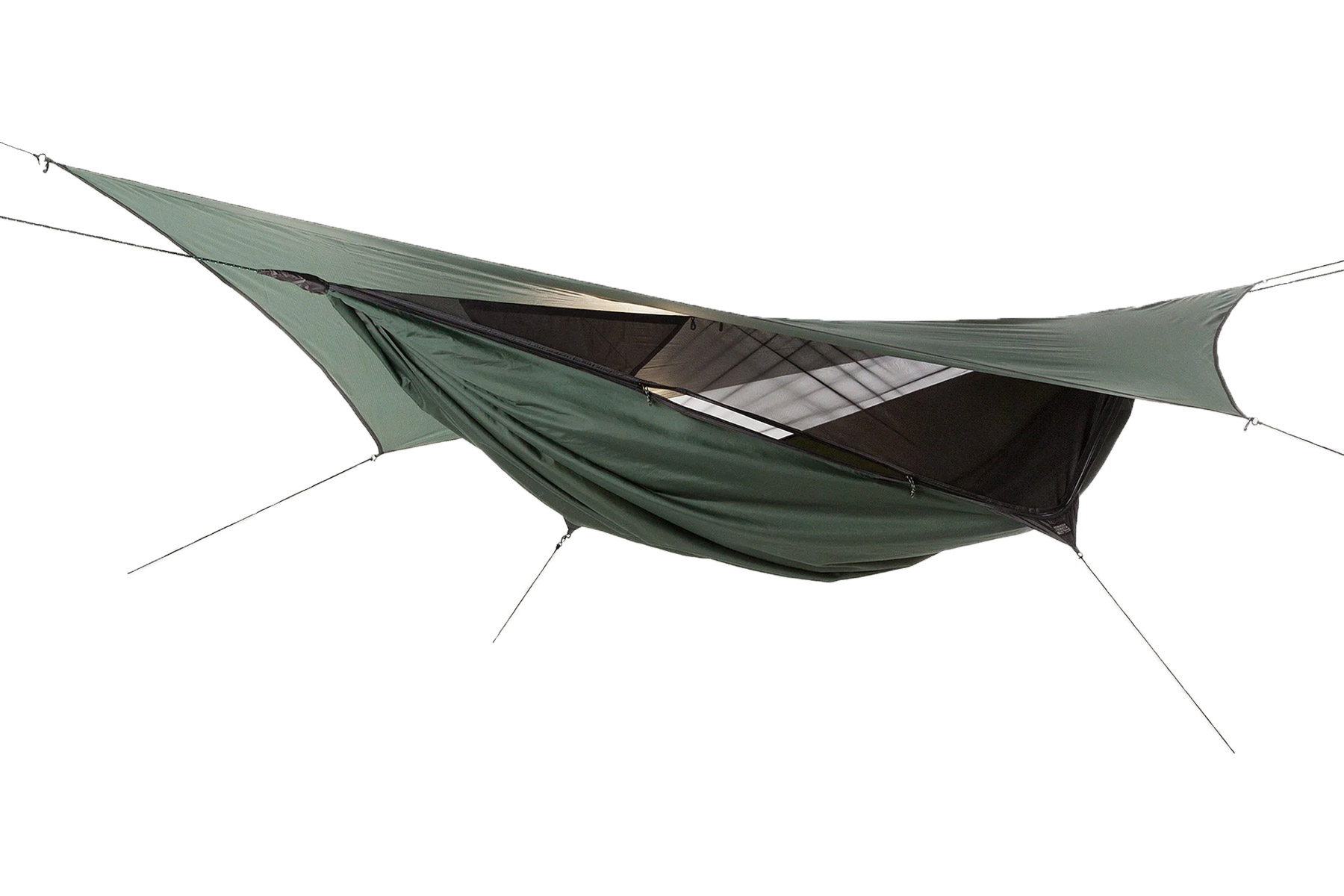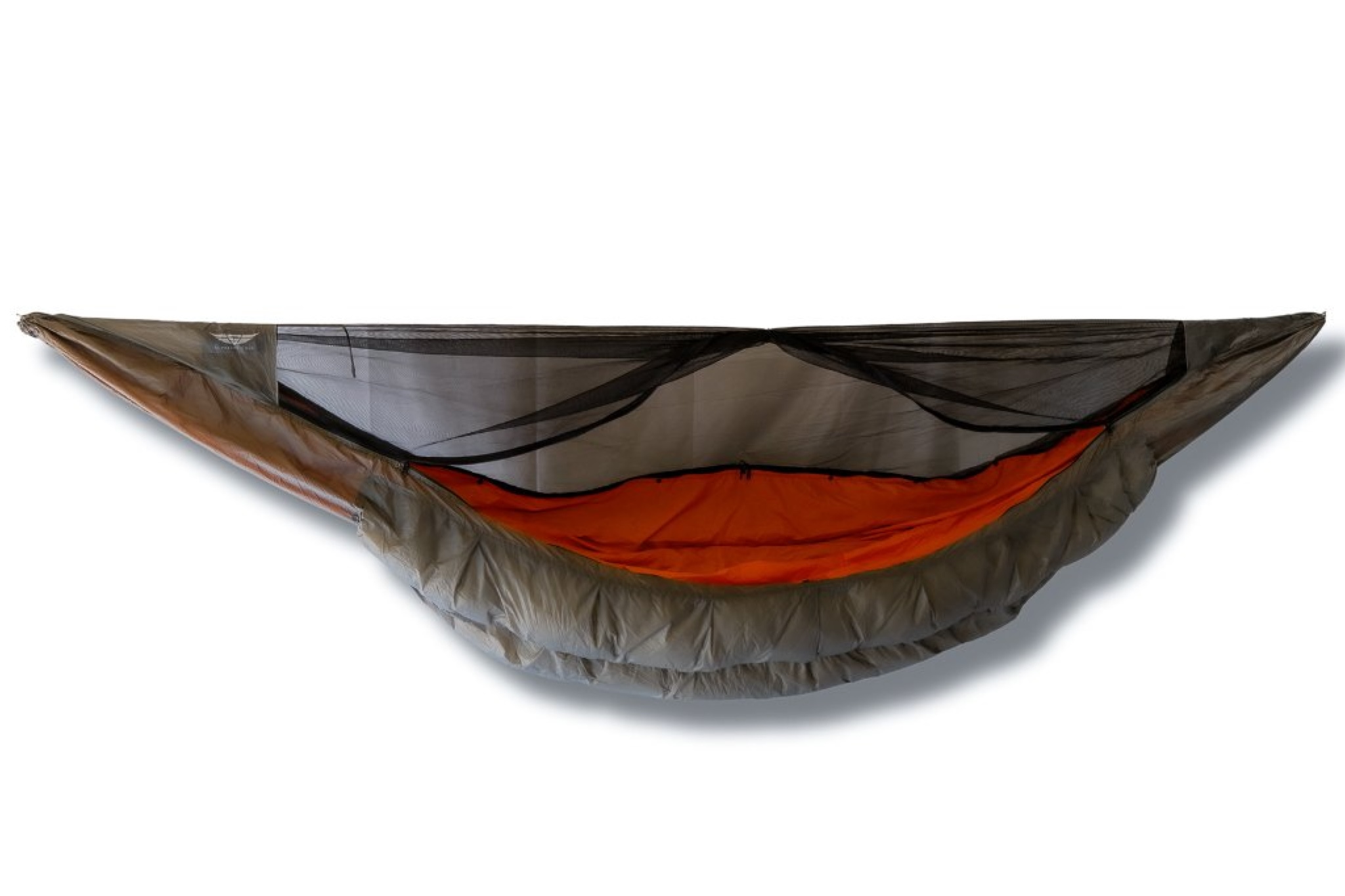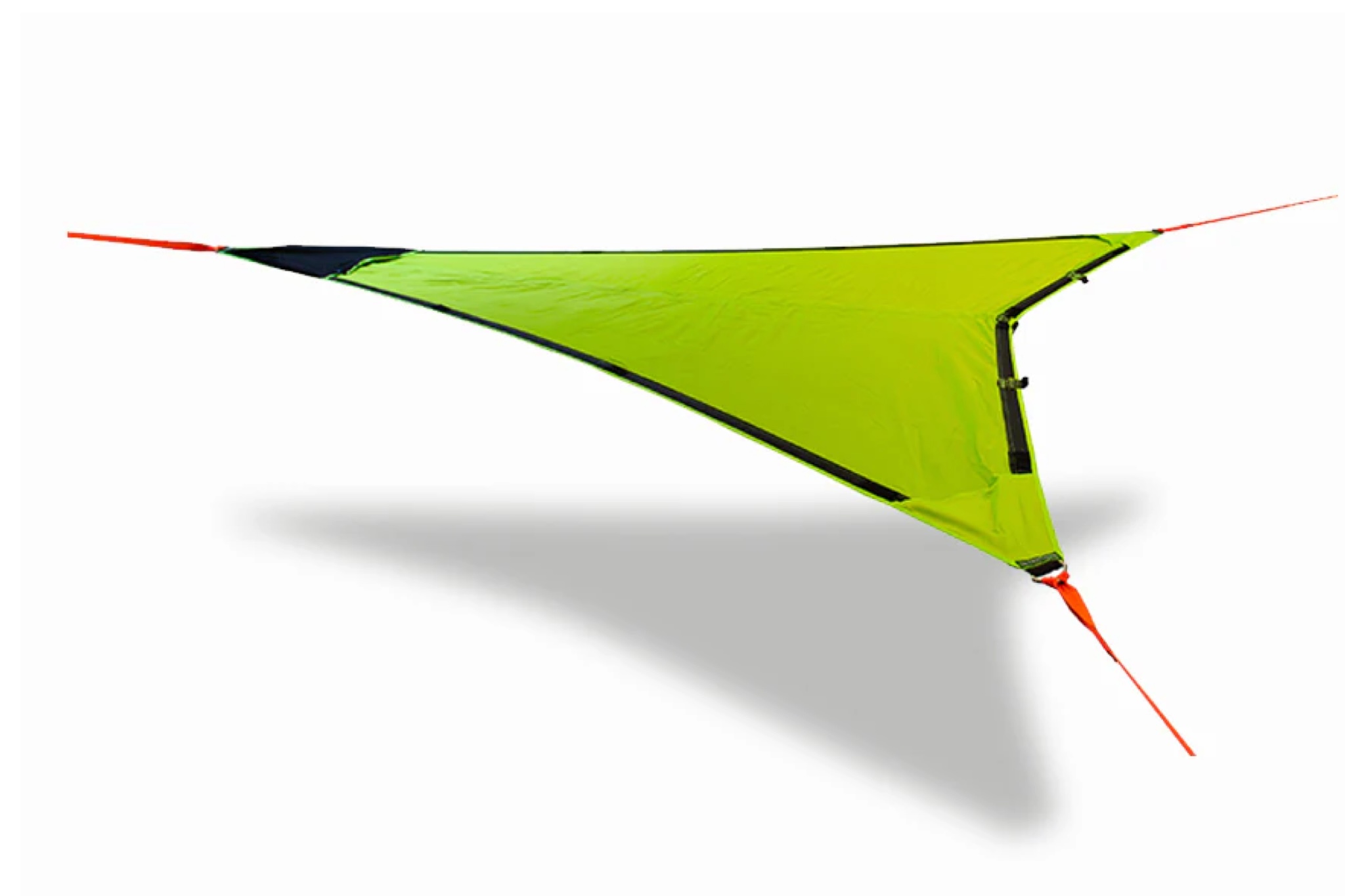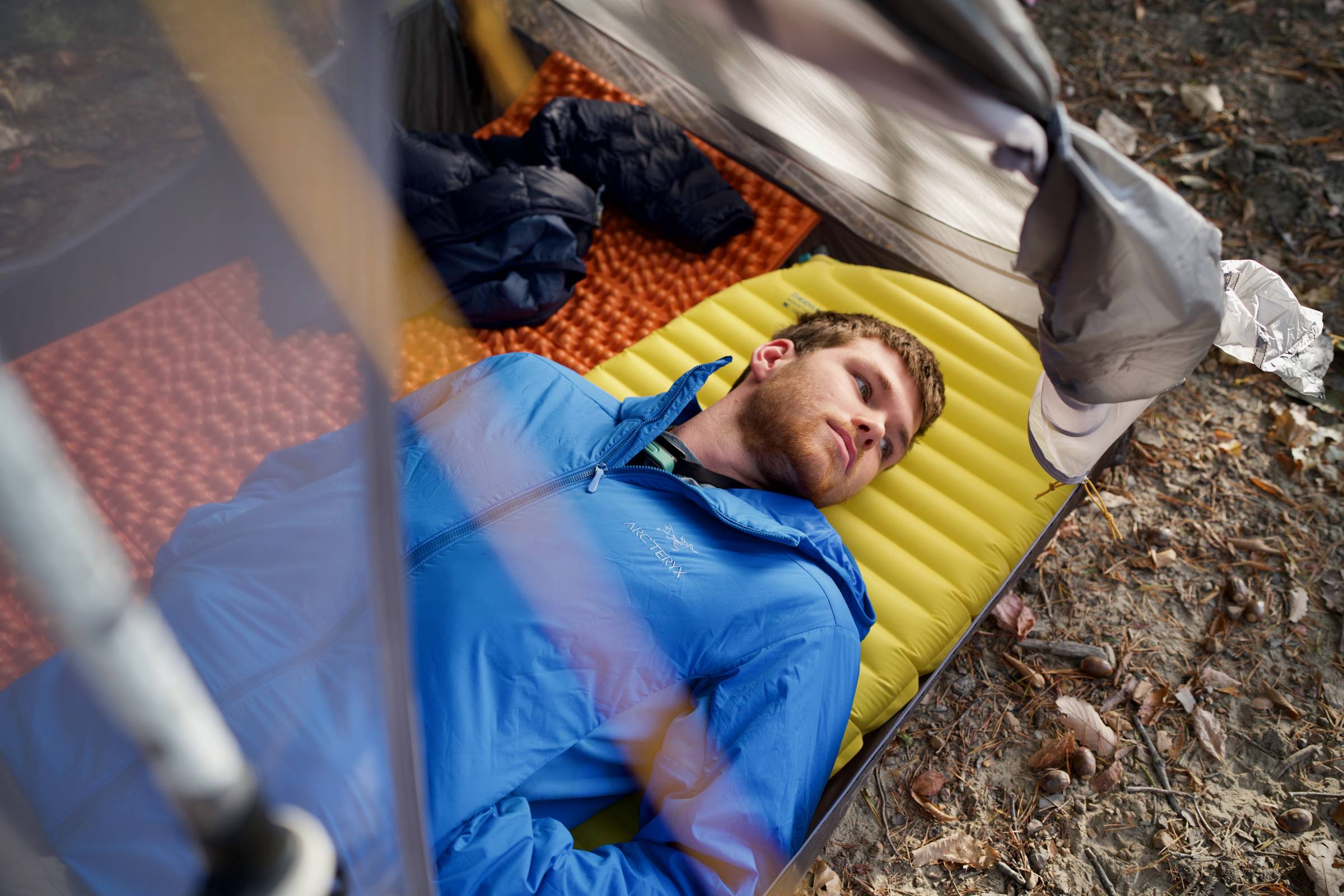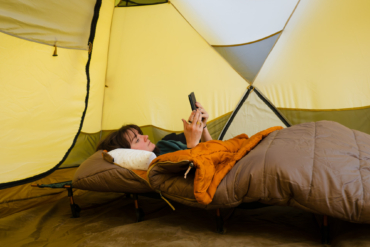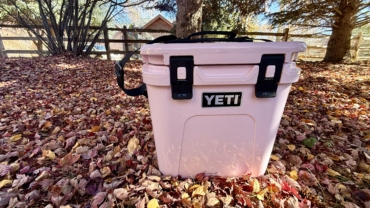Looking to kick back in style on your next backpacking or camping trip? We’ve spent hundreds of nights hanging in the best camping hammocks to bring you the essential options for your next trip. Whether you’re slinging up a comfortable seat on a day trip or needing a luxe thru-hiking shelter, we’ve spent time in them all.
In recent years, lighter and more packable styles have supplanted the heavy, old-school rope hammocks that used to hang in almost every suburban backyard. Now you can choose from hardcore hammock shelters like the Warbonnet Ridgerunner, or just dip your toe in with a wallet-friendly Onewind Aerie.
We’ve tested and reviewed lots of options and have chosen the camping hammocks that we think are the best choices in 2025. We aren’t just hammock casuals, either — we set off on multi-day backpacking trips in our rigs and tested each on their comfort, suspension systems, weather protection, and more. There’s bound to be one (or three) that will fit your backcountry and backyard needs.
Editor’s Note: We updated our Camping Hammocks guide on May 12, 2025, to add the Superior Gear Performance Hammock — an all-in-one system that builds the underquilt directly into the sling and makes shoulder-season hanging a breeze. We also added the Tentsile Duo Hammock, a twin-occupancy hammock with a unique three-tree suspension.
The Best Camping Hammocks of 2025
Warbonnet Ridgerunner Hammock
- Total Weight: 2 lbs., 4.6 oz.
- Max Capacity: 200 lb. comfort cap for single-layered, 250 lbs. for double
- Dimensions: 10.1' long, 3' wide
- Materials: Single or double-layered 30 or 40D Dream-Tex fabric
- Best For: Hammock camping, extended canoe trips, or anyone who values comfort over all else
Pros
- Incredible spacious storage
- Best-in-class comfort
- Moderate weight
- Flexible customization options
Cons
- May not be comfortable for heavier/broad shouldered individuals
- Fewer underquilt options
- Netting can be tricky to set up without a ridgeline
Onewind Aerie 11’ Double Camping Hammock
- Total Weight: 2 lbs., 9.6 oz.
- Max Capacity: 500 lbs.
- Dimensions: 11 ft long, 68 in. wide
- Materials: 70-denier nylon Hexagon Ripstop
- Best For: Budget beginners looking for room, and modularity, to expand
Pros
- Budget price
- Relatively light and plenty durable
- One-stop-shopping modularity
- Includes suspension, ridgeline, bug net, and organization
Cons
- Bottom-entry bug net can make entry and exit difficult
- Difficult to loosen if overtightened
- Heavy suspension
Eagles Nest Outfitters DoubleNest
- Total Weight: 1 lb., 3 oz.
- Max Capacity: 400 lbs.
- Dimensions: 9.5' long, 76" wide
- Materials: FreeWave 70-denier nylon taffeta
- Best For: Casual hanging at the beach or park, or going anywhere, really
Pros
- Ease of setup
- Large ecosystem of ENO accessories
- Many color and print options
- Wide width makes sitting perpendicular in the hammock easy
Cons
- No included suspension system
- The extra fabric can be a bit much when used solo
Hennessy Expedition Zip
- Total Weight: 2 lbs., 15.1 oz.
- Max Capacity: 250 lbs.
- Dimensions: 10' long, 59" wide
- Materials: 70D nylon
- Best For: Campers and backpackers who want versatility and modularity
Pros
- Reliably flat and comfortable lay
- Tons of modular accessories
- Streamlined design
- Built-in side shelves wrangle overnight gear inside your hammock
Cons
- Suspension setup is more involved
- The included tarp is small, with low clearance
- Additional shelter accessories come with involved setup
Warbonnet Blackbird XLC
- Total Weight: From 1 lb., 5.75 oz. (single-layer version without straps)
- Max Capacity: 350 lbs. configured as single-layer, 400 lbs. as heavyweight double
- Dimensions: 11 ft. long, 62 in. wide. 112 in. ridgeline
- Materials: 40-denier Dream-Tex ripstop nylon
- Best For: Tent campers who want a lot of options
Pros
- Easy to build to your specs
- Can be set up on the ground
- Comes standard with zip-in mosquito netting
- Internal storage shelves for essentials
- High-quality Dream-Tex ripstop is soft-faced and durable
Cons
- Maybe too many options for most people
- Ordering from a smaller hammock company can mean out-of-stock options
Hennessy 4Season Expedition Zip
- Total Weight: 5 lbs., 3 oz. (including straps)
- Max Capacity: 250 lbs.
- Dimensions: 10 ft. long, 59 in. wide
- Materials: One layer of 70-denier nylon, and one layer of 40-denier
- Best For: Those who like to camp in a hammock all year long
Pros
- Can easily adjust to battle a wide range of temperatures
- Asymmetric design allows for a comfortable sleeping position
- Included foam pad doesn't bunch up like traditional sleeping pads
- Hex rainfly is broad and protective
Cons
- Heavy and bulky
- Can be a bit complicated to set up
Superior Gear Performance Hammock
- Total Weight: 2 lbs., 13 oz. (entire system)
- Max Capacity: 350 lbs.
- Dimensions: 11' long, 56" wide
- Materials: Ripstop nylon
- Best For: All-in-one system lovers, and camping into the shoulder seasons
Pros
- Integrated underquilt takes the fuss out of hammock insulation
- Bug netting system is full-coverage and can be removed
- Simple tree strap and whoopie sling suspension available
- Built-in adjustable ridgeline
Cons
- Won't be as versatile at very warm temperatures (75°F+)
- Higher price of entry
Other Hammocks To Get Your Swing On In
- Total Weight: 2 lbs., 14.5 oz.
- Max Capacity: 500 lbs.
- Dimensions: 10 ft. long x 56 in. wide. 115-inch ridgeline
- Materials: 40-denier diamond ripstop nylon hammock body
- Best For: All-around camping, long backpacking trips
Pros
- Lightweight all-in-one design
- Sturdy with well-thought-out details
- All-integrated system
- Wide Python tree straps distribute weight around tree well
Cons
- Fixed-length ridgeline doesn’t work for everyone
- Daisy chain straps aren’t the most packable for hammock camping
- Doesn't excel at any one thing perfectly
- Total Weight: 1 lb., 12.8 oz.
- Max Capacity: 400 lbs.
- Dimensions: 9.1 ft. long, 55 in. wide
- Materials: 75-denier polyester hammock body
- Best For: Those who need a solid, no-frills camp hammock
Pros
- Budget price
- Light and durable
- Includes suspension straps and carabiners
- Soft-faced fabric is smoother than parachute materials
Cons
- Minimal features
- 9 foot length won't fit everyone
- Total Weight: 1 lb., 3 oz. in Hexon 1.6 fabric
- Max Capacity: 200 – 350 lbs. depending on fabric choice
- Dimensions: 11 ft. long, 57 in. width. 100 in. ridgeline length
- Materials: Available in Hexon 1.0, 1.2, 1.6, and Cloud 1.4 fabrics
- Best For: When conditions are unknown, and adaptability is king
Pros
- Available in many different fabric weights and prints
- Different bug nets and top covers increase adaptability
- Four different types of fabrics available, with custom printed design options
- Toothed zipper used on bug net connection is higher quality than coil zippers
- 11' standard length is roomy
Cons
- Will require a little work to fine-tune
- Zipper on the edge can catch on things
- Total Weight: 15 lbs., 16.4 oz. (entire system)
- Max Capacity: 880 lbs.
- Dimensions: 13' long, 8.8' wide
- Materials: 240D nylon/polyester composite
- Best For: Chilling at camp or the backyard
Pros
- Occupancy for two without being crammed together
- Integrated storage is out of the way and generous
- Very high weight capacity
- Choice of solid or mesh material
Cons
- Entire system weight is a bit hefty, and better suited for close-to-vehicle camping
- Requires a specific trio of anchors to set up properly
- Total Weight: 5.8 oz.
- Max Capacity: 300 lbs.
- Dimensions: 9 ft. long, 48 in. wide
- Materials: 30-denier ripstop nylon
- Best For: Those wanting an ultralight hammock for day trips or while front-country camping
Pros
- Ultralight weight of 'sub-6' ounces
- Very compact packed size
- Can be used with daisy chain or ultralight whoopie sling style suspension systems
- 30-denier fabric is surprisingly durable
Cons
- Doesn’t come with a suspension system
- 48" width is a bit snug, but not too small
- Total Weight: 4 lbs., 15 oz. (including straps)
- Max Capacity: 275 lbs.
- Dimensions: 7.5 ft. long, 90 in. wide
- Materials: Ripstop nylon and poly mix
- Best For: Shorter backpacking excursions or trips where weight and size aren’t as much of a concern
Pros
- Comfortable sleeping area
- Lots of room and can be set up on the ground
- Integrated rainfly
- Quadruple stitched sewing limits stretch
Cons
- Fairly bulky and heavy
- Complicated design
- Total Weight: 2 lbs.
- Max Capacity: 250 lbs.
- Dimensions: 7 ft. long, 36 in. wide
- Materials: 40-denier NewWave nylon
- Best For: Campers who want a lay-flat hammock
Pros
- Lay-flat comfort in a small, portable package
- Lightweight at 2 pounds
- Can be used with daisy chain or whoopie sling suspensions
Cons
- Can’t remove the bug net
- Lower max capacity
- Can't upgrade the hammock as you can with cottage industry options
Camping Hammock Comparison Chart
| Camping Hammock | Price | Total Weight | Max Capacity | Dimensions | Materials |
|---|---|---|---|---|---|
| Warbonnet Ridgerunner | $130-175 | 2 lbs., 4.6 oz. | 200-250 lbs. | 10.1′ long, 3′ wide | Single or double-layered 30 or 40D Dream-Tex fabric |
| Onewind Aeirie 11’ Double Camping Hammock | $70 | 2 lbs., 9.6 oz. | 500 lbs. | 11′ long, 68″ wide | 70-denier nylon hexagon ripstop |
| Eagles Nest Outfitters DoubleNest | $75 | 1 lb., 3 oz. | 400 lbs. | 9.5′ long, 76″ wide | FreeWave 70-denier nylon taffeta |
| Hennessy Expedition Zip | $170 | 2 lbs., 15.1 oz. | 250 lbs. | 10′ long, 59″ wide | 70-denier nylon |
| Warbonnet Blackbird XLC | $200 | From 1 lb., 5.75 oz. | 350-400 lbs. | 11′ long, 62″ wide; 112″ ridgeline | 40-denier Dream-Tex ripstop nylon |
| Hennessy 4Season Expedition Zip | $290 | 5 lbs., 3 oz. | 250 lbs. | 10′ long, 59″ wide | One layer of 70-denier nylon, and one layer of 40-denier |
| Superior Gear Performance Hammock | $420 | 2 lbs., 13 oz. | 350 lbs. | 11′ long, 56″ wide | Ripstop nylon |
| Kammok Mantis | $250 | 2 lbs., 14.5 oz. | 500 lbs. | 10′ long x 56″ wide; 115″ ridgeline | 40-denier diamond ripstop nylon hammock body |
| Klymit Traverse | $65 | 1 lb., 12.8 oz. | 400 lbs. | 9.1′ long, 55″ wide | 75-denier polyester hammock body |
| Dutchware Chameleon | $152 | 1 lb., 3 oz. in Hexon 1.6 fabric | 200-350 lbs. | 11′ long, 57″ wide; 100″ ridgeline | Available in Hexon 1.0, 1.2, 1.6, and Cloud 1.4 fabrics |
| Tentsile Duo Hammock | $249 | 15 lbs., 16.4 oz. (entire system) | 880 lbs. | 13′ long, 8.8′ wide | 240D nylon/polyester composite |
| Eagles Nest Outfitters Sub6 | $70 | 5.8 oz. | 300 lbs. | 9′ long, 48″ wide | 30-denier ripstop nylon |
| Lawson Blue Ridge Camping | $229 | 4 lbs., 15 oz. | 275 lbs. | 7.5′ long, 90″ wide | Ripstop nylon and poly mix |
| Eagles Nest Outfitters SkyLite | $170 | 2 lbs. | 250 lbs. | 7′ long, 36″ wide | 40-denier NewWave nylon |

How We Tested the Best Camping Hammocks
The GearJunkie team is chock full of avid hammock campers. To compile this list, we put our heads together and shared our passionate opinions on hammock camping, compiling a list of hammocks to test.
For this particular list, we’ve included hammocks that can be used for car camping and casual hangouts, as well as a few backpacking models. Testing hammocks is a lot of fun, but we still made sure to pay extra attention to the nitty gritty: How durable and comfortable the hammocks are. The amount of stretch they have or adjustability they boast. How easy and flexible they are to set up — not only the first time but also the twentieth.
Our Testing Process and Testing Grounds
Our hammock field testing takes us far and wide, and we’ve used these setups on everything from quick weekend overnights to extended bikepacking trips. We’ve also strung up these hammocks as simple camp chairs during day hikes and used them for park hangouts for an afternoon. We paid close mind to the complexity of setup, and we always subject each hammock to an initial ‘no-instructions’ go of getting them up.
Besides this, we also looked closely at comfort while laying in them and cycled through testers of different sizes and builds to get feedback from a diverse user group. Used as camping shelters, there’s a lot to also consider, including ease of set up when trees aren’t perfect, the protection provided from any included tarps, and how effective any integrated storage is.
We also broke out the scales for this roundup and weighed each setup in-house to ensure that manufacturers’ claims were accurate. In addition, we measured lengths and widths and compared hammock fabrics by looking at feel, durability, and water resistance. And when the rain didn’t provide itself when testing hammock shelters out, we rolled out the garden hose and made our own in order to test weather protection.
Our Expert Testers
Contributor Ian Graber-Stiehl has been hammock camping through picturesque mountainsides, forests, and crystalline streams for four years. More importantly, he’s stubbornly stuck with hammocks even in ill-advised conditions: in the middle of the deserts, the midst of swamps, and through below-zero blizzards.
Obsessive about gear, Ian spends hours tinkering and optimizing hammock setups to save a few seconds and grams — that he spends on yet more gear. For our testing here, he carried and hung each hammock tested in a variety of different ways and weather conditions, and with different tarps and insulation, to see how they perform in a wide range of conditions.

Buyer’s Guide: How to Choose a Camping Hammock
Camping hammocks are versatile pieces of gear that can reliably replace a tent and provide the joy of daytime lounging. In the past few decades, hammocks have become increasingly popular with outdoor recreationists rediscovering the beauty of tent-free camping.
To those experienced outdoor sleepers who swear by the tent, hammock camping may at first seem like a novelty activity reserved for backyard fun. However, thanks to innovative product design and the development of handy accessories, hammocks have become a completely legitimate and viable alternative to tents. And, given the setup, can even rival some ultralight tents for weight and packed size.
Before you buy a hammock, consider exactly how and where you’ll be using it. Will it be mostly for daytime use? Will you frequently use the hammock in cold or wet weather? Are the areas where you plan to use your hammock buzzing with mosquitos? Hone in on which features you can and can’t live without. Read on for more details regarding weight, value, ease of setup, accessories, durability, protection, and versatility.
Hammock Types: Gathered-End vs. Bridge
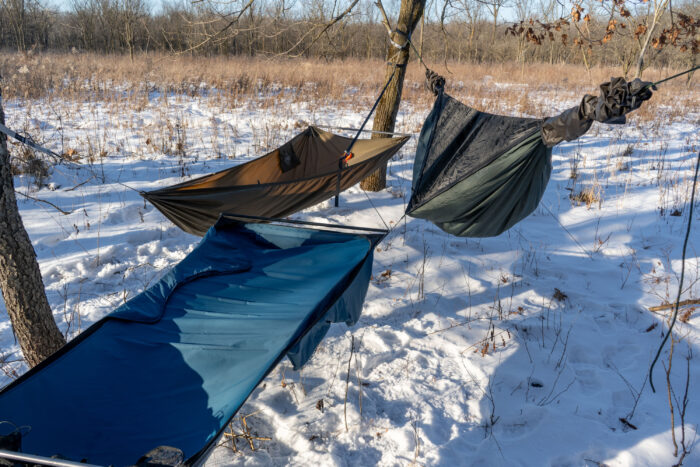
While the original hammocks were all of the gathered-end variety, other permutations have arisen that provide a different style of lay. Finding which style is right for you will come down to how you like to relax, and how and where you like to camp.
Gathered-End Hammocks
Traditional gathered-end hammocks bring the fabric together at two points on opposite ends of the hammock, creating a pea-pod or banana shape that allows you to lay sideways within the fabric. You’ll always have a bit of a sag lying in this position, which works well for some but may not for others.
Gathered-end hammocks win over other styles when it comes to packability, as they are about as simple as you can get with a single piece of fabric stretched between two loops of cordage. They also tend to be cheaper than other styles for the same reason. Our lineup is dominated by this style of hammock, with excellent examples being the Kammok Mantis, Eagles Nest Outfitters DoubleNest, and Hennessy Expedition Zip.

Bridge or Spreader Bar Hammocks
While gathered-end hammocks taper towards bunched ends where the fabric is cinched together, bridge hammocks are closer to the picturesque beach hammocks most people picture, leveraging some sort of spreader bar. This flattens out hammocks for a side sleeper-approved lay, at the expense of weight and a tippier feel. However, modern camping hammocks have come a long way toward overcoming these disadvantages.
Relatively short aluminum and carbon fiber spreader bars are not only lightweight themselves. They don’t require the length and width of gathered-end hammocks to achieve a flat lay. Especially with double-layered hammocks and underquilts, their more compact designs can go a long way towards offsetting both extra ounces and the tippy feel. However, bridge hammocks can involve more pieces, have lower weight ratings, are often less customizable, and their bars can minimize clearance beneath a tarp.
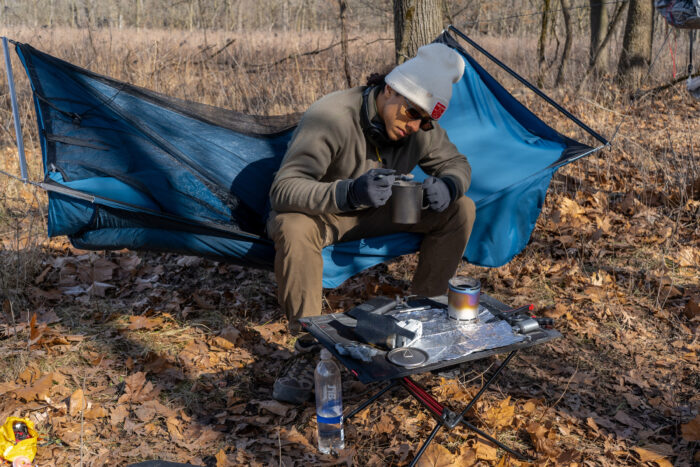
Fabrics
Fabric is often denoted by its denier rating, which is a measure of the thickness of the fibers used to make it. A higher denier will mean a more durable fabric, while a lower one will be more fragile, but also more lightweight.
In our testing, we found that the most common denier for a hammock was around 75-denier, with the range spanning from the ultralight 30-denier ripstop of the Eagles Nest Outfitters Sub6, to the burly 240-denier of the Tentsile Duo Hammock.
Fabrics also will be referred to by their weights, often given as ounces per yard squared. In terms of hammocks, something like a 1.9-ounce ripstop nylon will be on the heavier end of fabrics, while a 1.0-ounce is on the ultralight side of the scale.

Nylon
Nylon is by far the most popular fabric for camping hammock construction, harkening back to the Vietnam-era Jungle hammock produced for the U.S. Army. Today, many hammocks will be made with something similar to 1.1-ounce nylon.
The term ripstop refers to the calendared weave that can be sewn into a fabric as it is produced. This raised pattern resists allowing a tear to continue throughout a fabric once it’s begun. Some fabrics use a different denier yarn for the ripstop grid versus the base fabric, creating a strong but still lightweight fabric.
Proprietary
Many manufacturers will work with textile mills to produce their own nylon fabrics to their specifications, allowing them to fine-tune the weight, strength, and feel of the fabric. Notable in this category are cottage-industry brands such as Warbonnet or Dutchware, which often will offer hammocks in a selection of different fabrics for users who want to dial in their kit.

Weight
Weight is an especially important factor for those who plan to carry a hammock from campsite to campsite. Though backpacking hammocks aren’t the focus of this list, we included both lightweight hammocks and heavier options.
First, it’s important to consider that the total weight of a hammock alone isn’t all that telling. To set up a hammock to sleep in, you’ll also need at least a suspension system.
This means ropes or straps that attach to the anchor points of your hammock, wrap around trees or other fixed objects, and keep the entire rig suspended.
A lightweight hammock and a heavy suspension system can easily cancel each other out. This same principle applies to rainflies and other accessories you may need.
Remember that lightweight materials are often thinner and more fragile than other options. Still, for those looking to shave grams off their total weight, it’s possible to put together a hammocking setup that’s significantly lighter than almost any one-person tent.

Hammock Suspension Systems
Setting up a hammock is a simple process that basically entails attaching your suspension system between two trees or other fixed points and hanging both ends of your hammock from the system.
Though the basic process is simple, some hammocks are quicker and easier to set up than others. In general, we recommend that you practice setting up your hammock at a park or in your backyard a few times before going hammock camping.
While many hammocks are set up according to a standard hammock design with two symmetrical anchor points and a cocoon-like shape, other hammocks on the market have slightly different designs that can add some tricky subtlety to the setup process.
Asymmetrical hammocks require the user to lay somewhat diagonally inside the hammock to create a flatter sleeping surface.
Depending on your accessories, setup can become convoluted and somewhat arduous. If you need a bug net, we recommend purchasing one that’s built into the hammock’s construction. This will save you a step and shorten your overall setup time.

Daisy Chain Straps
Often accompanying entry-level or casual hammocks, daisy chain straps borrow from the world of climbing and are about as easy as it gets when you want to sling up for a quick snooze. Often made from nylon webbing, these straps sport multiple sewn pockets that are used to shift the distance between the hammock and tree. They don’t allow as much fine-tuning of the tension as other systems, but when we’re hammocking for fun or don’t mind the extra weight and bulk, daisy chain straps are what we reach for first.
Many hammock users will be familiar with the ENO Atlas straps ($30), which we find to be easy to use, and appreciate the reflective accent stitching to limit awkward nighttime stumbles. An easy upgrade (at no extra cost, even) is to go with the Kammock Python 10 straps, which add an extra 12 inches to each strap, and are a smidge lighter.
Whoopie Slings
Using the same tech as the paper finger traps we all played with as kids, whoopie slings are adjustable and lightweight suspension systems that are often made from a polyethylene rope called Amsteel. Highly packable, these are the strap style of choice for serious hammock campers.
Whoopie slings will need to connect to a thick tree strap in order to protect the trees you’re hanging from if they aren’t integrated into them. The Whoopie Hook Complete Suspension ($36) from Dutchware is the whole shebang and our favorite of the bunch.

Buckle Suspension
Similar to whoopie slings, buckle suspensions are popular among hammock campers for their adjustability and packability. These straps wrap the tree like a daisy chain but utilize a cinch buckle on the hammock ends to hold tension.
The Titanium Cinch Buckle Complete Suspension from Dutchware ($35) is the crème de la crème, utilizing space-age materials, but we also like the Complete Polyester Webbing/Buckles Suspension from Warbonnet Outdoors ($23).
Structural Ridgelines
Since hammocks are only suspended at two ends, that leaves plenty of room for things to get out of whack when you’re hanging. In order to get an optimal hanging angle — which is roughly 30 degrees from your hammock strap to the ground — many will use a piece of cordage to connect the ends of the hammock.
Since many hammocks are between 10 to 11 feet long, corresponding ridgelines are available to give you the perfect hang, every time. These will often be between 100 to 110 inches long. The price of the Hammock Gear Structural Ridgeline ($8) is hard to beat, but if you want to play around with your angles, adjustable ridgelines are available from companies like Dutchware.
Ridgelines are also an excellent place to hang things you might need during the night, such as a lantern, or you can use a ridgeline organizer for added versatility.

Shelter Systems
Outside of the fairest weather and in areas without mosquitos, hammocks are not an entire campsite unto themselves. They need overhead protection from the rain, underside insulation from the cold, and potentially even more to weatherize your sleep system. Fortunately, we’ve rounded up a simple shortlist of recommended gear to extend the range and forecast of your camping experience.
Hammock Tarps
Hammock tarps are waterproof nylon covers that protect your hammock from the elements — most notably, rain and snow. They function exactly like the rainflies that are found on tents and are made from the same DWR-treated nylon.
A rainfly should cover your entire hammock. We recommend purchasing one designed specifically for the make and model of your hammock, to ensure proper coverage. Some hammock systems, like the Kammok Mantis or Hennessy 4Season Expedition Zip, come with a tarp included in the bundle.
Tarps are typically measured by the length of their intended setup. Adding a few feet of length over the overall length of your hammock is a good way to ensure proper coverage. While there are a number of options for fabrics, the big three are silnylon, silpoly, and Dyneema.

Silnylon is durable and abrasion-resistant, but stretches the most when wet. Silpoly stays taut in the rain, but is easier to poke a hole through. Dyneema offers the most tensile strength, stiffness, and water resistance, and is the easiest to patch, but costs far more.
Tarp designs are also a spectrum. On the fast and lightweight end are asymmetric tarps like the Hennessy Rainfly ($50). They offer the least protection from driving rain, especially for ground-bound gear, but offer a simple setup and compact storage. Hexagonal tarps, such as Dutchware’s Bonded Xenon Tarp ($147) offer a step up in protection while still keeping extra fabric to a minimum.
Rectangular tarps like Onewind’s 12’ Billow ($90) are the Light Heavyweights of the pack, offering maximal coverage and multi-configurability. Often, the ends of the tarps can cinched together, closing them like doors for better weatherproofing. One step up into true, all-weather capability would be tarps with rectangular bodies and dedicated door flaps like Warbonnet’s Superfly ($150).
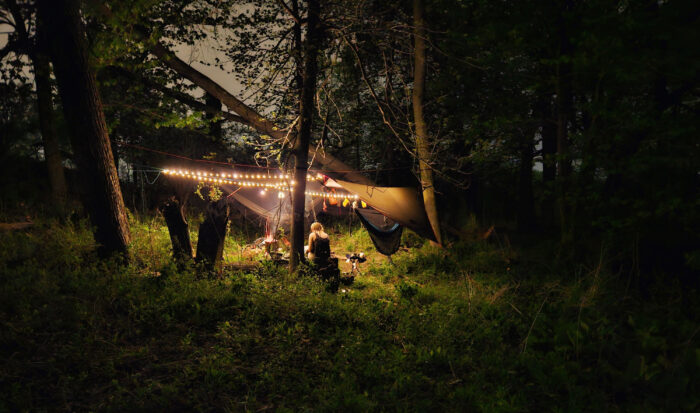
Sleeping Pads
Sleeping pads offer an insulation alternative. Given their lower weight-to-warmth ratio than underquilts and a tendency to slide around, they typically work best in double-layered hammocks. Sandwiched between two layers, they sit still, trap a pocket of warm air, and can even make for a flatter lay.
We find that sleeping pads are better for extending the temperature range of a hammock setup, rather than being its insulation backbone. For nights in the low 60’s, we’ve found budget-friendly, lightweight foam pads line the NEMO Switchback ($55) to be insulative enough on their own. There are also a few dedicated hammock pads, such as Klymit’s Hammock V ($200), which features wings to widen a hammock.
Finally, there are a few dedicated hammock sleeping pad systems. The Hennessy 4Season Expedition Zip notably favors sandwiching a foam pad between your hammock and a water-resistant undercover. Combined with their heat-reflective pad, the system can hang warm and comfortably in 40-degree temps.
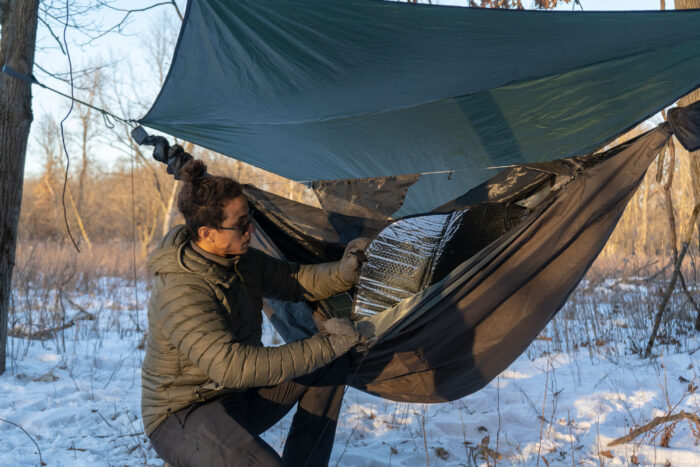
Tarp Suspension
There are two main ways of hanging a tarp, and it comes down to the ridgeline used to suspend it. Most tarps come with a split ridgeline — a line attached to either end of the tarp. Split ridgelines keep extra cordage to a minimum and are easy to re-tension if a tarp stretches. However, split ridgelines are more difficult to center perfectly over a hammock, and can be slower to set up.
Continuous ridgelines, meanwhile, are longer, continuous lengths of cordage, typically 30-50 feet long. They offer an incredibly easy setup: Whether with a tensioning device or a know, string the line taut. Clip the tarp into prusik loops, and slide the loops to tension the tarp.
Continuous ridgelines make setup and centering a breeze. They allow the backbone of a tarp to stay taut while putting less stress directly on the tarp. However, a continuous ridgeline means more rope to wind back up and more weight to carry. Hanging a tarp beneath a continuous ridgeline, especially with stretchy cordage and long spans, can also reduce the height and clearance of a tarp.
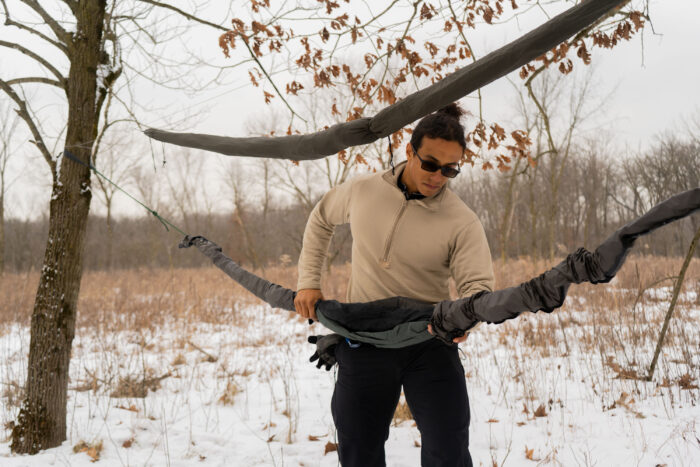
Underquilts
Insulating underquilts keep you from losing body heat through your exposed underside while lying in a hammock. On warm summer nights, an underquilt may not be necessary, but when it’s frigid out, they’re a must-have.
Basically, an underquilt is a blanket that hangs under your hammock and conforms to the shape of your body. The underquilt prevents heat from seeping out through your underside. Some high-end cold-weather underquilts are rated all the way down to -20 degrees Fahrenheit.
They come in different lengths including full-body, half-length, or three-quarter length. Of course, a full-length underquilt will be the warmest option, but for those concerned with the weight of their kit, shorter quilts can be a great solution. Similarly, down stuffing offers the greatest warmth-to-weight ratio. This is reflected in cost. Synthetic filling offers a budget alternative but with a weight penalty.
If the fuss of going down the hammock accessory rabbit hole is too much for you, consider a built-in system like the Superior Gear Performance Hammock, an 11′ hammock with a down-filled underquilt sewn directly into the sling.
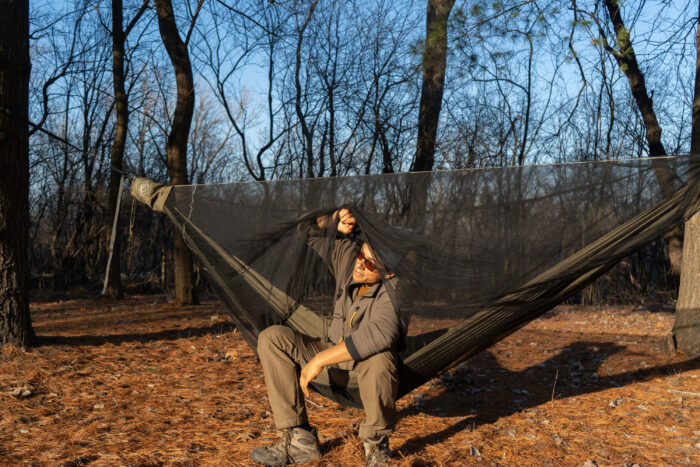
Bug Nets
If you’re heading to notoriously buggy regions like the Pacific Northwest or the Colorado alpine, a bug net is essential. In a tent, bugs aren’t too much of a concern because tents typically come with fully enclosed mesh bodies. However, without a net in an open hammock, you’ll likely become dinner for hordes of mosquitoes.
For hammocks without integrated nets, separate ones are sold that fully enclose the hammock and usually open and close with a zipper. These have been available for some time, and we’ve had great luck (no bites yet) with the ENO Guardian Bug Net ($65). Hammock camping together? The Birds Nest Bug Net ($115) from Dutchware is designed to hang over two adjacent hammocks.
Many hammock manufacturers now are offering integrated bug net solutions as add-ons to their hammocks, using a zipper system for quick on-and-off deployment. The Warbonnet Blackbird XLC and Kammok Mantis are in this group.

Durability
Because most hammocks are made from thin nylon, the denier rating of the material will tell you a lot about the overall durability of the hammock. The denier rating describes the thickness of the fibers, and the higher the denier rating, the more abrasion-resistant the hammock. Ripstop nylon is also a trusty choice for hammock construction.
In general, treat your hammock like the fragile piece of gear it is. Because hammock material is thin, it’s vulnerable to ripping, melting, and fraying. If you handle your hammock with gentle care, it should last for many years — especially if it’s high-quality, like the options on this list.
Weather Protection
Some hammocks are made from material that is treated with a DWR coating. While this can be helpful, ideally, your hammock will never actually get wet.
Be sure to set up your hammock so that it is as protected from the elements as possible. In cold, wet weather, top and under covers can provide extra protection for underquilts and trap more warmth around you. Gear-wise, a quality rainfly will go the longest way towards improving the weather range of your hang. However, smart positioning is paramount. Even a generous tarp can struggle in driving rain and cold winds when hung at the wrong height, with a bad angle, at a site with no windbreaks.
As a source of shelter, a hammock really can be as effective as a tent in most scenarios. With proper setup and the right accessories, a night in a hammock should be warm, cozy, and dry — even when it’s pouring rain or dumping snow.
Accessories
These days, there are a whole lot of interesting and potentially useful accessories available on the hammock market, aside from just bug nets and underquilts.
A perennial favorite of ours are snakeskins, sleeves that protect hammocks and tarps, and streamline setups. Simply suspend your hammock and slide the sleeves back — or leave it wrapped and out of the way while doing camp chores.

On the extreme end, Dutchware’s Anaconda ($95) can swallow a hammock, underquilt, and top quilt or sleeping bag, all into one package. Hennessy’s SnakeSkins ($18), which come free with their hammocks, are wide enough to pack both hammocks and rainflies together. For campers who want to keep their packs light, wallets full, and rainfly and hammock separate, Onewind’s 12’ Two-Piece Sleeves ($18) provide a cheap, ultralight option.
We’ve found that accessories for rewrapping ridgelines and tie-out cordage like Dutchware’s Cord Winder ($0.75-2.50) and Onewind’s Mini Tarp Reel ($25) can also streamline tarp suspensions — keeping line untangled and more readily at hand. There are also numerous accessories for expanding the storage of a hammock setup. Favorites of ours for keeping gear dry and off the ground include Hammock Gear’s Ridgeline Organizer and Onewind’s Pack Cover/Gear Hammock Hybrid.
Versatility
The primary job of a camping hammock is to provide a comfortable and reliable shelter for sleeping or lounging outside. That said, a little bonus versatility is always a good thing.
Though we don’t generally recommend sharing a hammock overnight with another person for comfort’s sake, two-person hammocks tend to be more versatile than one-person hammocks. On our list, the ENO DoubleNest is over 6 feet wide, meaning it can easily be used as a two-person lounging zone, or as a nice couch to sit in sideways during restful days in camp.
While some users may shy away from extra material because it means extra weight, it really is a nice luxury to be able to use your hammock for more than just hunkering down at night.
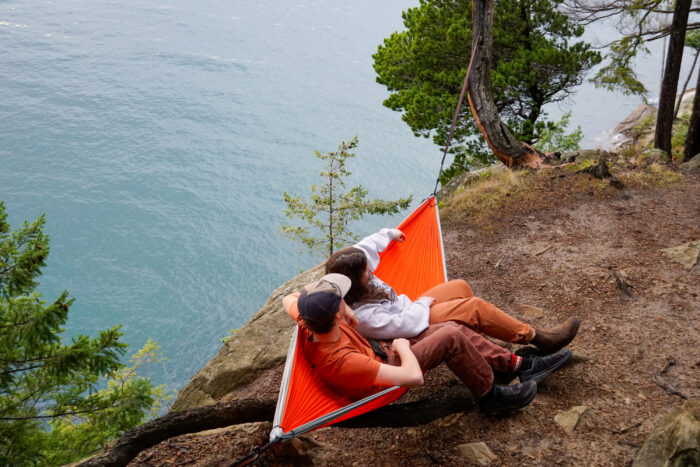
Price & Value
The price of a hammock is really twofold: The price of the hammock itself, and the cost of the rest of the gear you’d need to make it trail-ready. After testing so many hammocks, we’ve found most of them to fit into four categories.
Budget
On the low end of the price spectrum are entry-level lounging hammocks, like the ENO DoubleNest ($75) and Klymit Traverse ($65). Almost always gathered-end, the fabrics on these hammocks range, but their cuts typically skew short and wide — aiming for a flat lay by being a double hammock.
Budget trail hammocks and budget loungers are often only dollars apart, but trail hammocks are geared more toward backpacking use, and offer up more functionalities such as bug nets, ridgelines, and potentially some integrated storage options.
Hammocks like Onewind’s Aerie ($70), Northers ($102), or OneTigris’ Kompound ($80) are excellent examples of these easy-entry points into hammock camping.
Mid-Tier
These are typically the Hennessy and Kammoks of the hammock world. Mid-ranged hammocks are typically a step up in both construction quality and price. These hammocks tend to find more options for different fabrics and versions of various hammocks.
Hennessy, for example, offers numerous versions of its popular Explorer and Expedition hammocks, all of which utilize an asymmetric design for a flatter lay with less fabric. Kammok’s Mantis ($270 with tarp), meanwhile, leverages Bluesign-approved materials, pullouts to keep bug netting further away from your face, and tie-outs galore to support a diagonal lay.
The extras are often included and are well-engineered. Likewise, hammocks in this price range tend to be supported by a small array of well-designed accessories like tarp systems and shelter add-ons — to improve the hammocks’ capabilities.
Premium
Customizability and comfort are king among high-end hammock brands like Warbonnet and Dutchware. Hammocks like the Blackbird XLC (starting at $200) and Chameleon (starting at $135) take the first point to the nth degree, with dozens of potential configurations, reversible asymmetry, and numerous modular accessories to ensure that, no matter the conditions, you have exactly the hammock you want.
Some smaller makers, such as Dream Hammocks, even offer completely custom versions of multiple models. High-end bridge hammocks like the Ridgerunner (starting at $130) and Banyan (starting at $175) still offer a great deal of customizability. However, premium comfort is their stock in trade, offering, for our money, the most comfortable sleep in the woods this side of a cabin.
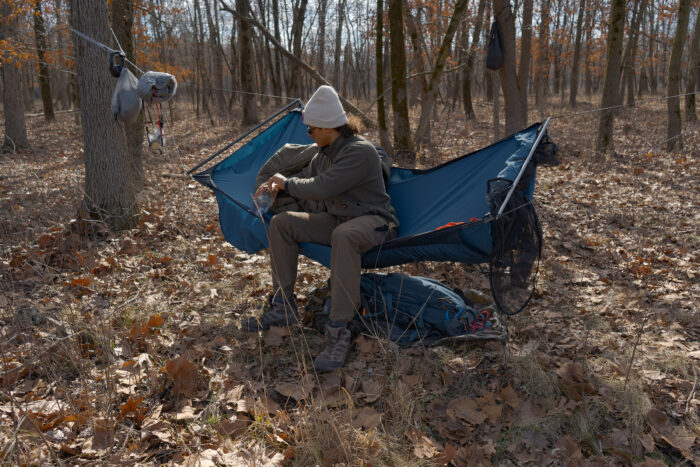
Frequently Asked Questions
Yes. When set up properly for the given conditions, hammocks are a safe alternative to tents when camping. Make sure you know how to set up your hammock before you go, and don’t forget to check the weather.
Accessories like bug nets and rainflies help ensure that you’ll be prepared for sleeping outside in a hammock.
Tents and hammocks are different, but they both provide adequate and reliable shelter for sleeping outside. Personal preference will determine whether you decide to use a hammock or a tent.
That said, there’s nothing better than a hammock for that sweet sensation of being gently rocked to sleep.
The short answer is no. Generally, a hammock is colder than sleeping in a tent, as the ground offers a surprising amount of insulation. That said, a hammock that’s geared out with proper insulation and shelter can be comfortable and warm — even in subzero temperatures. Be sure to find the right sleeping pad or underquilt for maximum warmth.
For the most severe winter conditions, four-season tents are still the gold standard.
A double hammock is made to support two people and is usually rated to safely hold at least 400 pounds. Two people can share a double hammock, but it’s usually pretty uncomfortable to actually sleep together with another person in a hammock.
Many single users prefer double hammocks. The extra material offers additional space to spread out, and some sleepers like to wrap the hammock’s material around them like a cocoon. Double hammocks are generally heavier, but they offer some nice comfort that you may find is worth the weight.
Sizing a hammock will come down to two dimensions: width and length. Width has been fairly standardized into ‘single’ and ‘double’ occupant designations, with single hammocks being around 5 feet in width, and double hammocks being around 6. A single hammock will save some weight and bulk over a double hammock, while a double will be more useful for hanging out in camp.
The length of your hammock will play a bigger role for those who are looking to sleep in their hammocks, with the range falling between 7 and 11 feet. For most people, a 9-10-foot-long hammock will suit all of their needs. Closely related to the length of your hammock will be the ridgeline length, which is a structural cord that runs between the ends of your hammock, and suspends the fabric at the correct angle.
When it comes to tuning in your ridgeline length, the consensus is to go with around 5/6, or 83%, of your hammock length.
First, choose a tree that is healthy and can support your weight. These will typically be 6 inches in diameter or greater, and living. Then, use a suspension system that can spread out the forces across the bark. A wide daisy-chain strap will be sufficient, but for more delicate trees you may choose to use a set of tree savers, which are straps that better pad and distribute these forces.
For the DIY types: tree savers can be improvised with strips of cardboard, or by using small sticks in between the strap and the tree. For the rest of us, Sea to Summit offers the Hammock Tree Protectors ($20).

The Best Camping Tents of 2025
We make finding the right camping tent easier for you by bringing you the best camping tents of 2025. Check out our top picks from REI Co-op, Kelty, NEMO, and more.

The Best Camping Mattresses of 2025
From packable sleeping pads to ultracomfortable air beds, we tested and found the best camping mattresses and sleeping pads to fit every adventure and budget.

